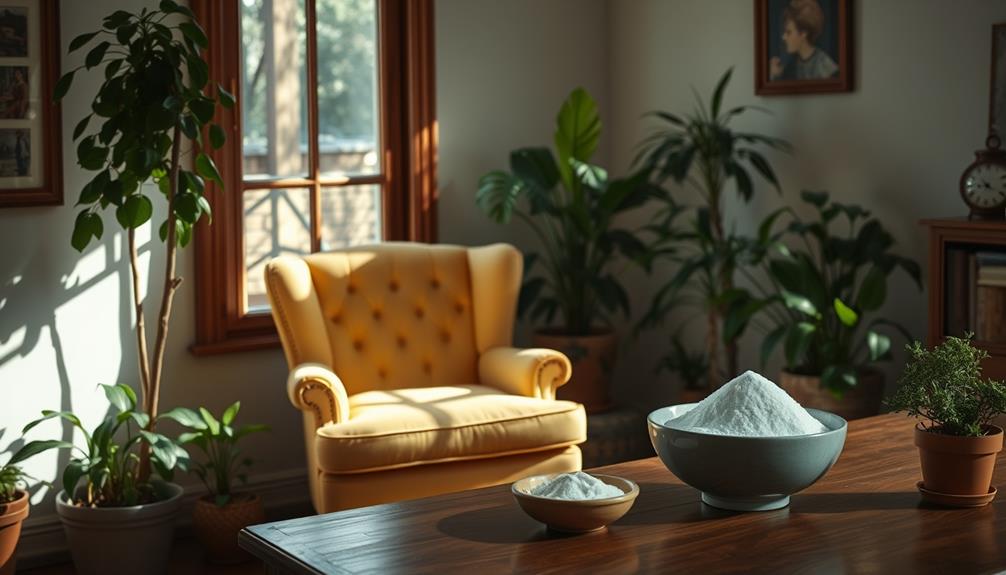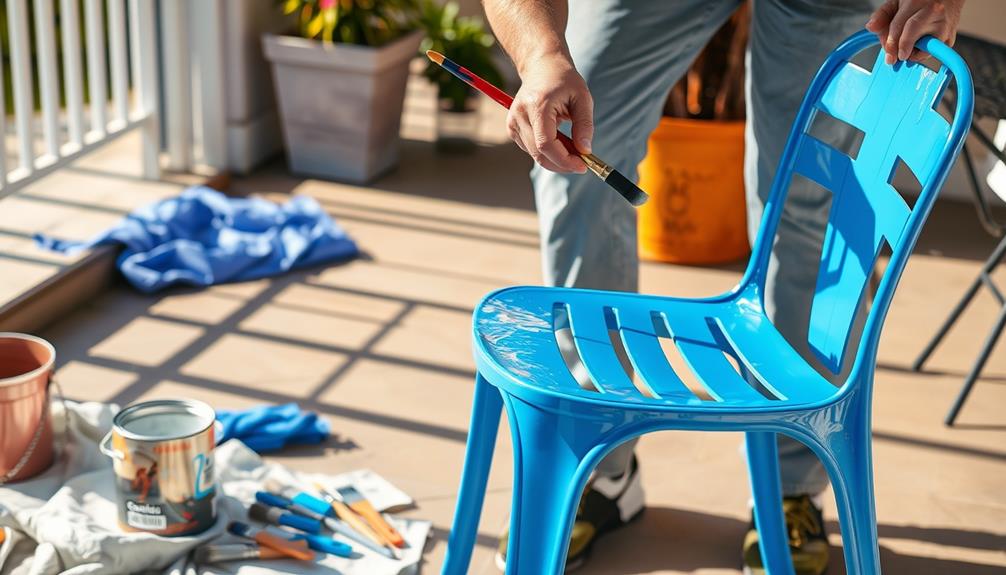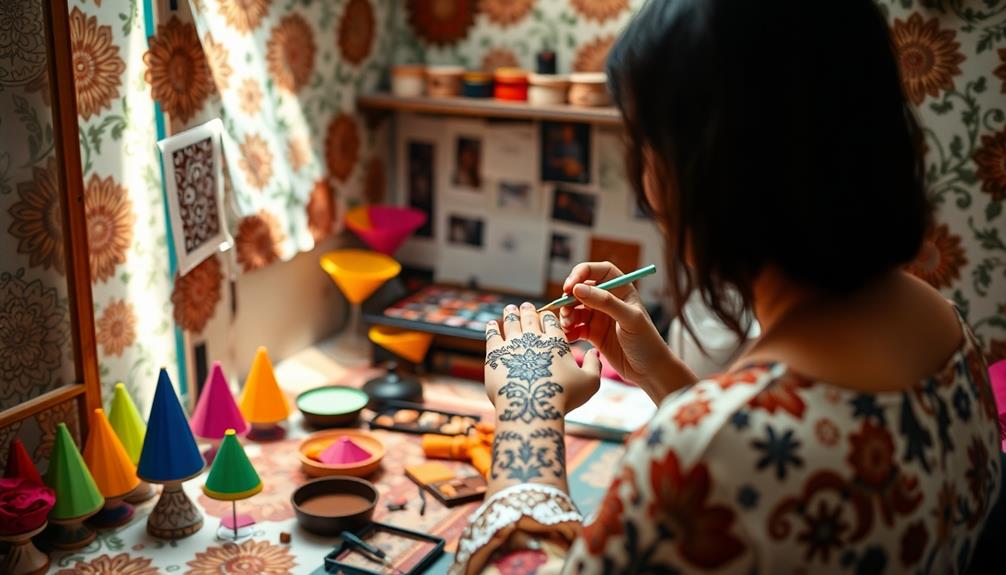To eliminate dimethyl fumarate from your sofa, begin by thoroughly vacuuming with a soft brush to remove loose particles. Next, gently wipe the surface with a dry cloth. For a deeper clean, combine equal parts white vinegar and water, lightly misting a cloth to dab at affected areas. You can also attempt a baking soda paste for tough spots. If household methods do not work, consider professional cleaning services specializing in leather to ensure a safe and effective approach. Regular vacuuming and conditioning can help extend the life of your sofa, and there is more to discover on this topic. Additionally, it is crucial to address other stains that may occur with time, such as food or drink spills. When dealing with tougher issues, like removing blood stains from sofa fabric, a mild detergent and cold water can often assist in lifting the stain without causing damage. Always test any cleaning solution on a small, inconspicuous area first to ensure no discoloration occurs.
Key Takeaways
- Vacuum the sofa using a soft brush attachment to remove loose DMF particles from all areas and crevices.
- Wipe the surface with a clean, dry cloth in a circular motion to lift residual DMF.
- Use a vinegar-water solution or specialized DMF removal products, testing first on inconspicuous areas.
- Consider professional cleaning services for effective DMF removal, ensuring they have experience with leather furniture.
- Maintain the sofa by regularly vacuuming, weekly wiping, and conditioning leather every 3-6 months.
Understanding Dimethyl Fumarate
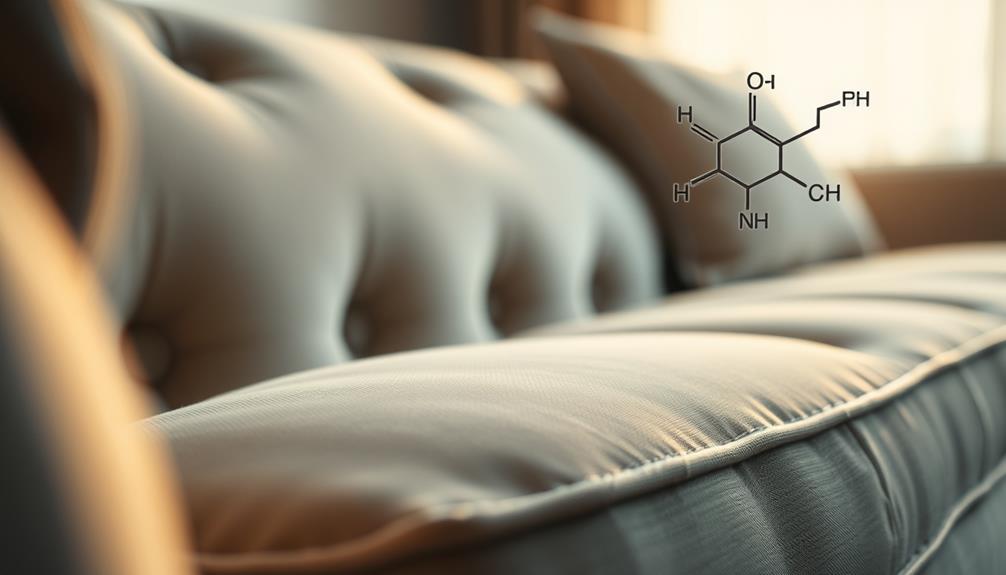
Dimethyl Fumarate (DMF) serves as a chemical preservative widely found in furniture, especially on leather surfaces, to combat mold and mildew. Its ability to inhibit microbial growth enhances the durability and strength of furniture materials, making it a popular choice for manufacturers.
However, DMF isn't water-soluble, which means it doesn't easily wash away with standard cleaning methods. This characteristic can pose challenges when it comes to maintaining your leather furniture. In addition to its use in furniture, common types of cold medications also require careful consideration to avoid adverse effects.
For those sensitive to DMF, its presence can trigger allergic reactions, leading to skin irritations. You might find that prolonged exposure to DMF can affect your comfort and health. That's why understanding its implications is crucial. If the chemical isn't properly removed, you risk damaging your leather furniture, causing cracking and peeling over time.
Recognizing the importance of effective cleaning techniques is essential for maintaining your furniture's appearance and longevity. As you explore the process of removal, keep in mind the potential risks associated with DMF, and prioritize safe practices to protect both yourself and your furniture.
Understanding DMF sets the stage for making informed decisions in your cleaning efforts.
Initial Cleaning Steps

Start by using a vacuum cleaner with a brush attachment to pick up loose DMF particles from your sofa's surface.
Regularly maintaining your air quality with methods like air purifier maintenance dos and don'ts can help prevent future issues.
Next, take a dry cloth and wipe away any remaining residues to guarantee a clean area.
Vacuum Cleaner Usage
Vacuuming the sofa is an essential initial step to effectively remove loose dimethyl fumarate (DMF) particles.
Begin the cleaning process by using a vacuum cleaner equipped with a soft brush attachment. This gentle tool will help you remove any loose DMF particles from the surface without damaging the fabric or leather.
It's important to guarantee a safe environment, as studies show that homes without protective measures can be at higher risk for various issues, including the presence of harmful substances like DMF increased safety and peace of mind.
Don't forget to vacuum all crevices and seams, as these hard-to-reach areas can harbor DMF particles.
Make sure to use a low suction setting while vacuuming. This helps avoid any potential damage to your sofa while still effectively picking up debris.
As you vacuum, regularly empty the vacuum cleaner's dust container. This practice maintains strong suction power and prevents the re-distribution of any collected DMF particles back onto the sofa.
Once you've finished vacuuming, you'll be ready for the next step in the cleaning process.
Wipe With Dry Cloth
After you've thoroughly vacuumed the sofa, it's time to address any remaining DMF particles. Grab a clean, dry cloth and start wiping the surface gently. This step is essential for removing loose DMF residues without pushing them deeper into the leather.
Regular cleaning of your upholstery can help maintain its appearance and longevity, similar to the importance of regular fuel injection cleaning for vehicle performance.
Here's how to do it effectively:
- Use a soft, lint-free cloth to avoid scratches.
- Wipe in a circular motion to lift residues efficiently.
- Regularly check the cloth for dirt buildup; replace it as needed.
- Make sure the cloth is completely dry to prevent spreading contaminants.
- Focus on one section at a time for a thorough clean.
Apply Vinegar Solution
To tackle the stubborn dimethyl fumarate (DMF) residues on your sofa, mixing a vinegar solution can be a game changer. Start by combining equal parts white vinegar and water in a spray bottle. This natural cleaning solution will help you effectively target those pesky residues.
Next, lightly spray the vinegar solution onto a clean cloth rather than directly onto the sofa. This prevents oversaturation and potential damage to the leather. Gently blot the affected areas of the sofa, allowing the vinegar to penetrate and break down the DMF without soaking the material.
After applying the solution, take a dry cloth and wipe the area to absorb any excess moisture, which helps prevent lingering odors. Remember, it's essential to test the vinegar solution on a hidden area of the sofa first to verify it doesn't impact the leather's color or finish.
| Step | Action | Purpose |
|---|---|---|
| Mix solution | Combine equal parts vinegar and water | Create a cleaning agent |
| Spray cloth | Lightly spray solution on cloth | Prevent sofa damage |
| Blot sofa | Gently blot affected areas | Break down DMF residues |
| Wipe with dry cloth | Remove excess moisture | Prevent odors |
Natural Cleaning Solutions

Natural cleaning solutions can be an effective way to tackle dimethyl fumarate (DMF) residues on your sofa without harsh chemicals. For those looking to enhance indoor air quality and eliminate odors, incorporating essential oils like eucalyptus oil can provide additional benefits while cleaning.
Here are some simple methods you can use to keep your furniture clean and safe.
- Vinegar Solution: Mix equal parts of white vinegar and water. This solution can help dissolve DMF residues on your sofa's surface.
- Baking Soda Paste: Combine baking soda with a small amount of water to create a paste. Apply it to affected areas and let it sit for 15 minutes before wiping clean with a damp cloth.
- Soapy Water Method: Use a mixture of mild soap and warm water to gently clean the leather, but be careful not to oversaturate it.
- Dry Cloth Wipe: Regularly using a soft, dry cloth can remove surface dust and DMF residues, preventing buildup over time.
- Test Natural Solutions: Always test any natural cleaning solution on an inconspicuous area of the sofa first to verify it doesn't cause any damage.
These natural methods aren't only safer for you and your furniture but can also be quite effective in keeping your sofa clean.
Specialized Cleaning Products

When it comes to effectively removing dimethyl fumarate (DMF) from your sofa, specialized cleaning products offer a reliable solution. These products are specifically formulated for leather, guaranteeing they remove DMF residues without damaging the leather's surface or integrity.
Proper care for leather furniture is essential, as it helps maintain its appearance and longevity, similar to ultimate hamster care. Many leather cleaners contain natural ingredients that neutralize DMF while also conditioning the leather, keeping it looking its best.
It's vital to choose a cleaner explicitly labeled for leather to avoid any adverse reactions that could lead to additional damage. Some specialized leather cleaning products even include protective agents that help prevent future buildup of DMF and other harmful substances. This added benefit can save you time and effort in the long run.
Always follow the manufacturer's instructions when using specialized cleaning products. This guarantees you're treating your sofa safely and effectively, maximizing the cleaner's potential while minimizing the risk of damage. In addition to using the correct products, consider employing deep sofa cleaning techniques to ensure a thorough clean, especially in hard-to-reach areas. These techniques can help remove built-up dirt, allergens, and stains that regular surface cleaning might miss. Regular maintenance combined with periodic deep cleaning will keep your sofa looking fresh and prolong its life.
Professional Cleaning Services

When it comes to removing dimethyl fumarate from your sofa, professional cleaning services offer significant advantages.
They use specialized equipment and techniques tailored to your sofa's materials, ensuring effective and safe cleaning.
Additionally, understanding the importance of budgeting for professional services can help you make informed financial decisions.
Plus, knowing how to choose the right service can make all the difference in maintaining your sofa's appearance and longevity.
Benefits of Professional Services
Hiring professional cleaning services can offer significant advantages when it comes to removing dimethyl fumarate (DMF) from your sofa. These experts bring specialized tools and cleaning agents that effectively eliminate DMF without harming your upholstery or leather.
Their deep cleaning techniques can reach residues that typical home cleaning might overlook, ensuring a thorough job. Additionally, their methodical approach to cleaning mirrors best practices in software quality assurance by ensuring that every step is followed systematically for ideal results.
Here are some key benefits of utilizing professional services:
- Expertise in Material Treatment: Professionals identify the safest methods for various materials, minimizing the risk of allergic reactions.
- Advanced Techniques: They use deep cleaning methods that penetrate more effectively than standard home cleaning.
- Post-Cleaning Conditioning: Many services offer conditioning treatments, restoring leather's suppleness and preventing future damage.
- Time and Effort Savings: You won't have to spend hours researching and attempting DIY methods, leaving the heavy lifting to the experts.
- Peace of Mind: Knowing your sofa is in the hands of trained professionals gives you confidence that it's being properly cared for.
Choosing the Right Service
Selecting the right professional cleaning service is vital for effectively removing dimethyl fumarate (DMF) from your sofa. Start by confirming the service has experience specifically with leather furniture and understands DMF removal techniques. This expertise is significant as improper cleaning can damage your sofa.
Additionally, consider the importance of financial considerations for elderly care when budgeting for professional cleaning services, especially if you're managing care for a senior loved one.
Look for certifications or accreditations that indicate the service provider is trained in safe cleaning practices for chemical contaminants like DMF. These credentials can give you peace of mind knowing they follow industry standards.
Don't hesitate to ask for references or reviews from previous clients who've dealt with similar DMF issues. This feedback can help you gauge the effectiveness of the service.
Inquire about the cleaning products and methods they use to confirm they're safe for leather and effective against DMF. Your sofa deserves careful treatment.
Maintenance Tips

Maintaining your sofa is essential to keep it free from dust and dimethyl fumarate (DMF) particles. A little regular care goes a long way in ensuring your sofa remains clean and safe. Here are some practical tips to help you maintain your sofa effectively:
- Vacuum regularly: Use a vacuum cleaner with a soft brush attachment to remove dust and DMF particles, minimizing allergens. Regular monitoring of your cleaning routine is critical for health, similar to how one would monitor soil moisture for plants like the String of Hearts best soil for String of Hearts plants.
- Wipe down leather: Every week, use a dry cloth to wipe the leather surface, preventing DMF residue buildup and preserving its integrity.
- Natural cleaning solution: Once a month, mix vinegar and water to create a gentle cleaning solution. This helps eliminate lingering DMF without harming the leather.
- Condition the leather: Apply a leather conditioner every 3-6 months to avoid drying and cracking, which can be worsened by DMF exposure.
- Ensure ventilation: Keep your sofa in a well-ventilated area to reduce moisture and microbial growth, effectively preventing DMF-related issues.
Safety Precautions
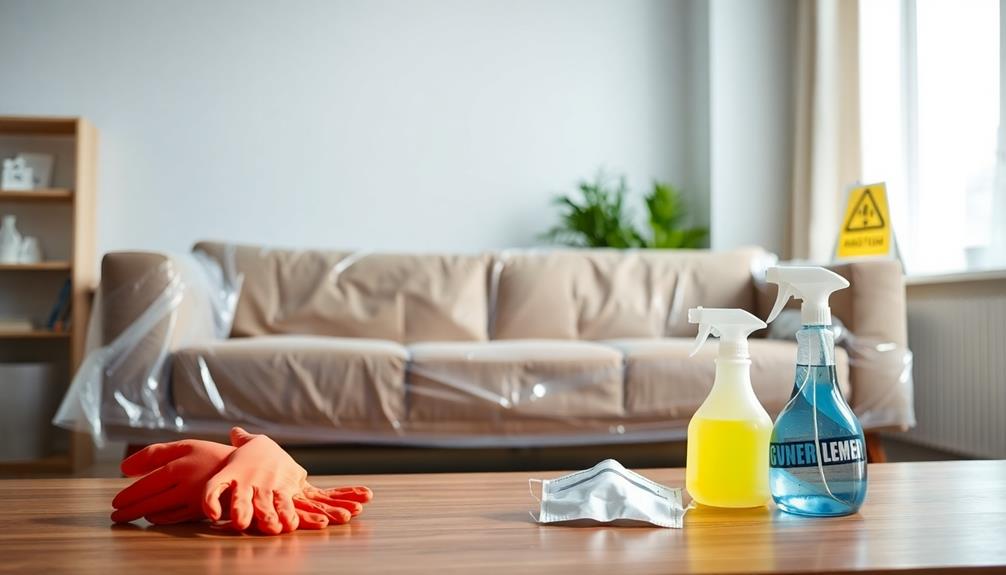
While keeping your sofa clean and well-maintained reduces the risk of dimethyl fumarate (DMF) exposure, it's also important to contemplate safety precautions during the cleaning process.
Always wear gloves and a mask when handling cleaning agents. This protects your skin and respiratory system from potential irritants associated with DMF.
Make sure the area is well-ventilated by opening windows or using fans. This minimizes inhalation of any airborne particles or fumes during the cleaning.
Before applying any cleaning solution, test it on an inconspicuous area of the sofa. This helps you avoid damaging the leather or triggering allergic reactions.
Keep all cleaning supplies and tools out of reach of children and pets to prevent accidental exposure to harmful substances.
If you experience any allergic reactions or skin irritations while cleaning, stop immediately and seek medical advice if necessary.
Frequently Asked Questions
How Do I Know if My Couch Has DMF?
To know if your couch has DMF, check for labels or tags, notice any musty smells, look for damage like cracking, and be aware of any allergic reactions you experience after using the sofa.
How Do You Remove DMF From Furniture?
Think of cleaning your furniture like a DIY project. Start by vacuuming to lift loose DMF particles, then wipe with a dry cloth, and use a vinegar-water mix to tackle any remaining residue effectively.
How to Remove Allergens From a Couch?
To remove allergens from your couch, vacuum regularly with a HEPA filter. Wipe surfaces with a dry cloth, use a vinegar-water mixture for cleaning, and apply gentle soapy water for deeper cleanings without harsh chemicals.
How to Remove Pilling From Sofa Fabric?
To remove pilling from your sofa fabric, use a fabric shaver or lint remover. You can also gently comb the fabric with a fine-toothed comb. Regular vacuuming helps prevent future pilling, keeping your sofa looking great.
Conclusion
In your quest to reclaim your sofa from the clutches of dimethyl fumarate, think of it as a knight battling a dragon. Armed with natural solutions and specialized products, you're on a noble journey to restore comfort to your castle. With each careful step, you're not just cleaning; you're forging a safe haven for relaxation. Keep your shield up with maintenance and safety measures, and soon, your throne will once again be a source of peace and joy.

